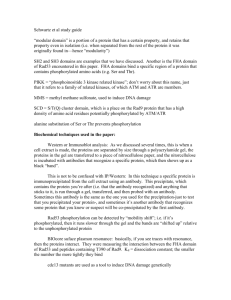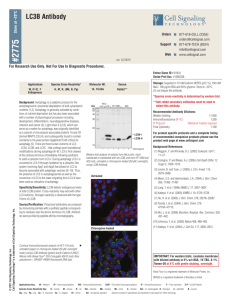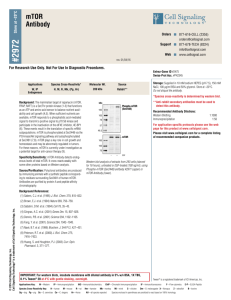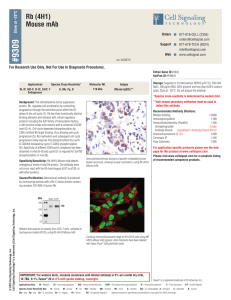Phospho-AMPKα (Thr172) Antibody - Cell Signaling Technology, Inc.
advertisement
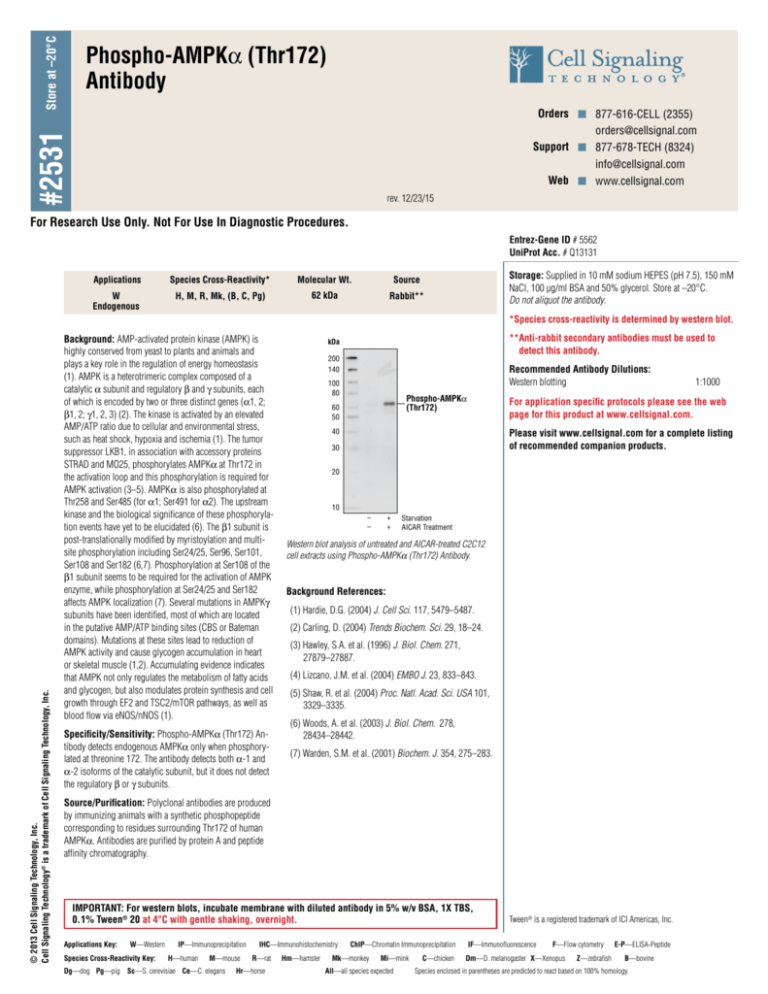
Store at –20°C Phospho-AMPKa (Thr172) Antibody #2531 Orders n 877-616-CELL (2355) orders@cellsignal.com Support n 877-678-TECH (8324) info@cellsignal.com Web n www.cellsignal.com rev. 12/23/15 For Research Use Only. Not For Use In Diagnostic Procedures. Entrez-Gene ID # 5562 UniProt Acc. # Q13131 Applications Species Cross-Reactivity* Molecular Wt. Source W Endogenous H, M, R, Mk, (B, C, Pg) 62 kDa Rabbit** Storage: Supplied in 10 mM sodium HEPES (pH 7.5), 150 mM NaCl, 100 µg/ml BSA and 50% glycerol. Store at –20°C. Do not aliquot the antibody. © 2013 Cell Signaling Technology, Inc. Cell Signaling Technology® is a trademark of Cell Signaling Technology, Inc. *Species cross-reactivity is determined by western blot. Background: AMP-activated protein kinase (AMPK) is highly conserved from yeast to plants and animals and plays a key role in the regulation of energy homeostasis (1). AMPK is a heterotrimeric complex composed of a catalytic α subunit and regulatory β and γ subunits, each of which is encoded by two or three distinct genes (α1, 2; β1, 2; γ1, 2, 3) (2). The kinase is activated by an elevated AMP/ATP ratio due to cellular and environmental stress, such as heat shock, hypoxia and ischemia (1). The tumor suppressor LKB1, in association with accessory proteins STRAD and MO25, phosphorylates AMPKα at Thr172 in the activation loop and this phosphorylation is required for AMPK activation (3–5). AMPKα is also phosphorylated at Thr258 and Ser485 (for α1; Ser491 for α2). The upstream kinase and the biological significance of these phosphorylation events have yet to be elucidated (6). The β1 subunit is post-translationally modified by myristoylation and multisite phosphorylation including Ser24/25, Ser96, Ser101, Ser108 and Ser182 (6,7). Phosphorylation at Ser108 of the β1 subunit seems to be required for the activation of AMPK enzyme, while phosphorylation at Ser24/25 and Ser182 affects AMPK localization (7). Several mutations in AMPKγ subunits have been identified, most of which are located in the putative AMP/ATP binding sites (CBS or Bateman domains). Mutations at these sites lead to reduction of AMPK activity and cause glycogen accumulation in heart or skeletal muscle (1,2). Accumulating evidence indicates that AMPK not only regulates the metabolism of fatty acids and glycogen, but also modulates protein synthesis and cell growth through EF2 and TSC2/mTOR pathways, as well as blood flow via eNOS/nNOS (1). Specificity/Sensitivity: Phospho-AMPKa (Thr172) Antibody detects endogenous AMPKa only when phosphorylated at threonine 172. The antibody detects both a-1 and a-2 isoforms of the catalytic subunit, but it does not detect the regulatory b or g subunits. **Anti-rabbit secondary antibodies must be used to detect this antibody. kDa 200 140 Recommended Antibody Dilutions: Western blotting 100 80 Phospho-AMPKα (Thr172) 60 50 For application specific protocols please see the web page for this product at www.cellsignal.com. Please visit www.cellsignal.com for a complete listing of recommended companion products. 40 30 20 10 – – + + Starvation AICAR Treatment Western blot analysis of untreated and AICAR-treated C2C12 cell extracts using Phospho-AMPKα (Thr172) Antibody. Background References: (1) Hardie, D.G. (2004) J. Cell Sci. 117, 5479–5487. (2) Carling, D. (2004) Trends Biochem. Sci. 29, 18–24. (3) Hawley, S.A. et al. (1996) J. Biol. Chem. 271, 27879–27887. (4) Lizcano, J.M. et al. (2004) EMBO J. 23, 833–843. (5) Shaw, R. et al. (2004) Proc. Natl. Acad. Sci. USA 101, 3329–3335. (6) Woods, A. et al. (2003) J. Biol. Chem. 278, 28434–28442. (7) Warden, S.M. et al. (2001) Biochem. J. 354, 275–283. Source/Purification: Polyclonal antibodies are produced by immunizing animals with a synthetic phosphopeptide corresponding to residues surrounding Thr172 of human AMPKα. Antibodies are purified by protein A and peptide affinity chromatography. IMPORTANT: For western blots, incubate membrane with diluted antibody in 5% w/v BSA, 1X TBS, 0.1% Tween® 20 at 4°C with gentle shaking, overnight. Applications Key: W—Western Species Cross-Reactivity Key: IP—Immunoprecipitation H—human M—mouse Dg—dog Pg—pig Sc—S. cerevisiae Ce—C. elegans IHC—Immunohistochemistry R—rat Hr—horse Hm—hamster 1:1000 ChIP—Chromatin Immunoprecipitation Mk—monkey Mi—mink All—all species expected C—chicken Tween® is a registered trademark of ICI Americas, Inc. IF—Immunofluorescence F—Flow cytometry Dm—D. melanogaster X—Xenopus Z—zebrafish E-P—ELISA-Peptide B—bovine Species enclosed in parentheses are predicted to react based on 100% homology.
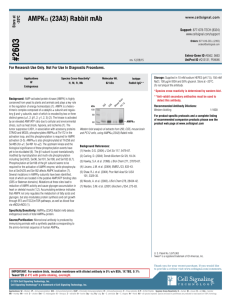
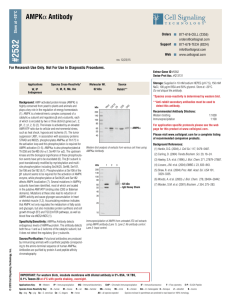
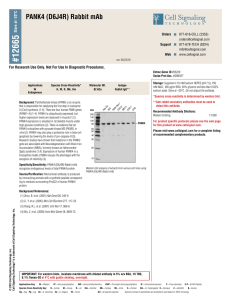
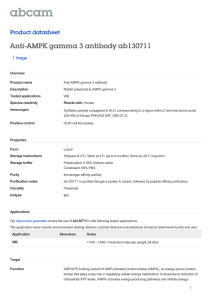
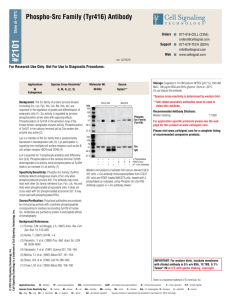
![Anti-AMPK beta 1 antibody [EP345] ab108250 Product datasheet 2 Images Overview](http://s2.studylib.net/store/data/011962595_1-d80ba860c02e5f5de11821bf9ebeb740-300x300.png)
